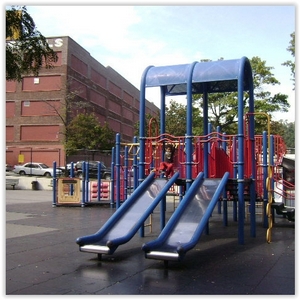 Marble Hill is the northernmost section of the Borough of Manhattan in New York City, United States. Marble Hill is part of the borough of Manhattan (and New York County) but is no longer on Manhattan Island.
Marble Hill is the northernmost section of the Borough of Manhattan in New York City, United States. Marble Hill is part of the borough of Manhattan (and New York County) but is no longer on Manhattan Island.
Because the neighborhood lies on the North American mainland alongside the borough of the Bronx, rather than on the island of Manhattan, it is often associated with the Bronx.
Broadway is the area’s primary thoroughfare. At the end of the 20th century national retailers opened outlets in the neighborhood.
Marble Hill has been occupied since the Dutch colonial period. On August 18, 1646, Governor Willem Kieft, the Dutch director-general of New Netherland, signed a land grant to Mattius Jansen van Keulan and Huyck Aertsen. This grant had comprised the whole of the present community. Johannes Verveelen petitioned the Harlem authorities to move his ferry from what is now the East River and 125th Street to the Spuyten Duyvil Creek because the creek was shallow enough to wade across, thus evading paying the toll. The ferry charter was granted in 1669.
Teunissen Place was named for Tobias Teunissen, a wool washer from Leyden, Holland, who came to the area in 1636. He applied and received a land grant to live in Inwood near 213th Street. Occasionally he had worked on the De La Montagne farm, which was located in what is now the Harlem section of Manhattan. Teunissen was killed in an Indian raid in 1655, and his wife and child were held hostage until they were ransomed by the Dutch authorities. The Dyckmans and the Nagles, who owned land in Inwood, purchased the Teunissen property in 1677.
Two bridges connected Marble Hill with the mainland. These were the Kingsbridge, constructed in 1693 by Frederick Philipse, and the Dyckman Bridge, constructed in 1759 by Jacobus Dyckman and Benjamin Palmer. The Kingsbridge was built as a toll bridge under Royal Charter for Frederick Philipse. The Dyckman Bridge was constructed as a toll-free bridge for the farmers who refused to pay the toll. Both bridges have been covered over with landfill. At 210 West 230th Street on the southwest corner of Broadway and 230th is a plaque designating the area as the site of the Kings Bridge. The Dyckman Free Bridge is located on the grounds of the Marble Hill Houses.
One of the local visiting spots during this period was a tavern operated by the Dyckman family. They had a tavern called the Black Horse Inn, located near McGown’s Pass in what is now Central Park. The Dyckmans sold the Black Horse to finance a new operation on the west side of Broadway and 226th Street that was to be managed by Benjamin Palmer, who owned property on City Island. It was situated to cater to the traffic from both bridges. In 1772 the Dyckmans sold the tavern to Caleb Hyatt and was known by the new owner’s name as Hyatt’s Tavern at the Free Bridge.
Even though it is separate from the mainland part of Manhattan, Marble Hill still enjoys the privileges of the borough. Residents who serve on jury duty are required to go to the distant courthouses at Foley Square in lower Manhattan. The residents enjoy the representation of the offices of City Council District 10 Manhattan as well as the elected officials of Manhattan and the Bronx. Bronx Community Board 8 oversees the day-to-day operations of Marble Hill.
